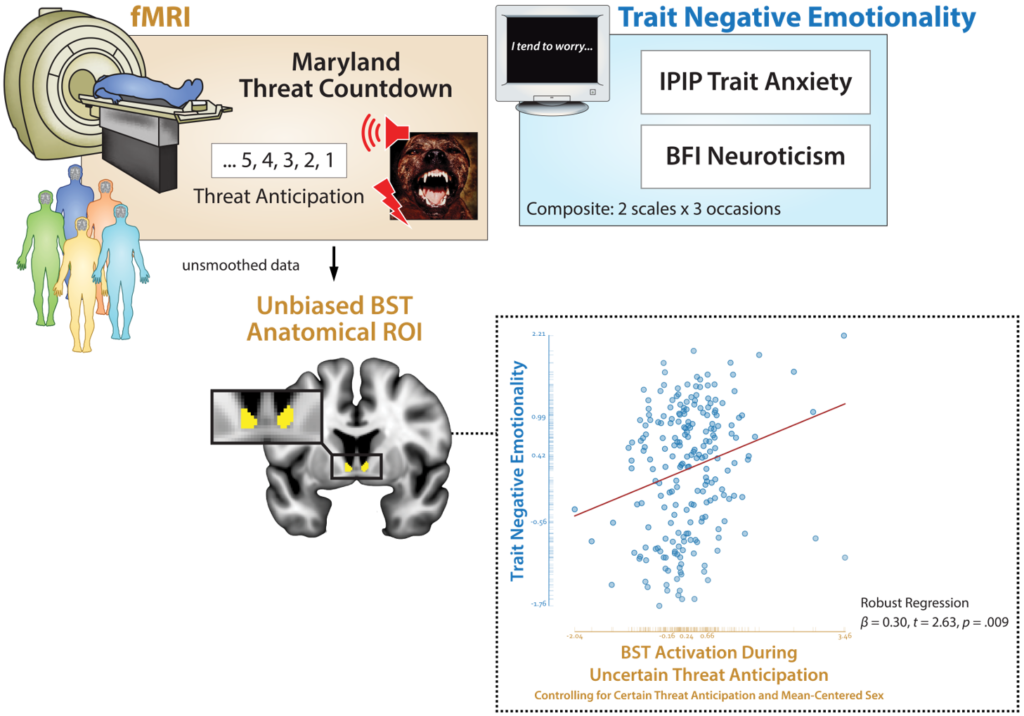Shannon’s pre-registered study was chosen as the winner of the first annual Reproducibility award at the annual meeting of the Society for Social Neuroscience (S4SN). Congrats, Shannon!

The central focus of the project was on clarifying the neural circuits underlying individual differences in Neuroticism/Negative Emotionality (N/NE). N/NE — the tendency to experience and express more intense, frequent, or persistent negative emotions — is a central dimension of mammalian temperament, and elevated levels of N/NE confer risk for a wide variety of adverse outcomes, from dissatisfaction and divorce to disease and premature death. The deleterious consequences of N/NE are particularly evident in the sphere of mental illness. Individuals with a more negative disposition are more likely to develop anxiety disorders and depression and, if they do, to experience more severe, chronic, and intractable symptoms. Yet the neural systems underlying trait-like individual differences in N/NE have remained enigmatic, impeding the development of more effective or tolerable interventions.
Shannon used a suite of neuroimaging and data science techniques to test the hypothesis that N/NE reflects heightened reactivity to impending threat in the central extended amygdala, including the central nucleus of the amygdala (Ce) and bed nucleus of the stria terminalis (BST). To ensure a broad spectrum of N/NE, 220 young adults were selectively recruited from a pool of nearly 7,000 pre-screened individuals. A multiband pulse sequence, best-practice data processing techniques, spatially unsmoothed data, anatomically defined regions-of-interest, and a cross-validated robust-regression framework enabled unbiased hypothesis testing with unprecedented anatomical resolution.
To clarify specificity, parallel analyses were performed using data from an emotional-faces paradigm. While ‘threatening’ faces are potent triggers of amygdala activity and widely used in on-going biobank projects, they do not elicit robust negative affect and are better conceptualized as a probe of emotion perception.
Results revealed that N/NE is associated with heightened BST activation during the anticipation of aversive stimulation, and this association is uniquely evident when the timing of aversive stimulation is uncertain. BST reactivity to uncertain threat remained predictive of N/NE after controlling for BST reactivity to certain threat or Ce reactivity to uncertain threat. In contrast, N/NE was unrelated to Ce activation during threat anticipation and BST/Ce reactivity to emotional faces.
While it is tempting to treat different ‘threat’ paradigms—from viewing photographs of ‘threatening’ faces to anticipating the delivery of noxious stimulation—as interchangeable probes of brain function, this has rarely been examined.
Follow-up analyses revealed no evidence of between-task convergence in the amygdala (Ce) and marginal evidence in the BST.
A large, sample and pre-registered, best-practices approach enhance confidence in the robustness and translational relevance of these results.
Together, these observations have implications for theory and practice and lay the groundwork for the longitudinal and mechanistic studies that will be necessary to determine causation and, ultimately, to develop improved interventions for extreme N/NE.
Grogans, S. E., Hur, J., Barstead, M. G., Anderson, A. S., Islam, S., Kim, H. C., Kuhn, M., Tillman, R. M., Fox, A. S., Smith, J. F., DeYoung, K. A., & Shackman, A. J. (2021). Neuroticism/negative emotionality is associated with increased reactivity to uncertain threat in the bed nucleus of the stria terminalis. Poster presented at the annual meeting of the Society for Social Neuroscience.